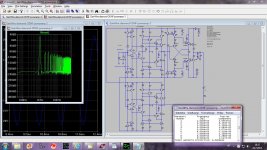Impressive! The question is, is this down to LTspice op amp models or is this discrete op amp that good?
Impressive! The question is, is this down to LTspice op amp models or is this discrete op amp that good?
Discrete op amp shows better result. With some famous op amps I couldn't stop oscilation for now.
I think to get this to work right what you need is a differential summing amplifier just to sum the input signal with the output signal and output the difference. The difference should be just the distortion product from the output stage. What you have right now is a huge amount of negative feedback summed with the input signal and output of your voltage amp.
Cheers,
No, it is not like that. At the op amp output there is only differnce between input and output, means error signal only, theoretically!
You're finding what I found trying to use this system in a Feedback amp. It just became impossible to get the stability and distortion cancellation.
Whether it's down to op amp models or not I do not know. I have given up simulating it for now but following this thread with great interest as you may find the answer.
Whether it's down to op amp models or not I do not know. I have given up simulating it for now but following this thread with great interest as you may find the answer.
No, it is not like that. At the op amp output there is only differnce between input and output, means error signal only, theoretically!
Yes but this only happens with a perfect null. It's not that easy to do. You have to have both the phase and amplitude matched tightly kind of like Bob's DM.
Cheers,
Hi David,
I tried first .ac and nothing indicated that there is going to be problem. The otput stage has compensation C1 and C5 is in the gain stage.
But here is interesting part. I used linuxguru opamp from http://www.diyaudio.com/forums/anal...screte-opamp-open-design-294.html#post3568890 and here is result.
Thats more like it 😉
The paper I supplied you shows ODNF applied with IC opamp but actual circuit used by Luxman uses discrete opamp although I think the problem with the IC opamps in sims is due to the models. I have a ODNF amp designed and built by a acquintance that is the designer for a commercial concern and uses IC opamp which operates very well with perfect clipping behaviour and has excellent THD figures for a NGFB amp. He sold me this experimental amp as I was quite pleased with the sound. He unfortuneatly will not be pleased if I were to dismantle the amp and publish the schematics here. The frontend he uses is same topology as seen in the paper which he also originally supplied me with.
BTW luxman use the folded cascode topology for the discrete opamp in latest amps, very much like lt1468 and ad826.
When can we expect PCB design 😀
Yes but this only happens with a perfect null. It's not that easy to do. You have to have both the phase and amplitude matched tightly kind of like Bob's DM.
Cheers,
Yes, nothing is perfect, complete nulling requires phase match and infinite opamp gain.
BR DAmir
Thats more like it 😉
When can we expect PCB design 😀
Ha, that's the question. This is the most complicated task, good PCB design is time demanding and here a help is welcome.
Damir
But here is interesting part. I used linuxguru opamp from http://www.diyaudio.com/forums/anal...screte-opamp-open-design-294.html#post3568890 and here is result.
Cool stuff - it actually works quite well, even for an application it wasn't designed for!
In practice, you'll have to match the LTP FETs and cascodes closely, in the discrete opamp, to get results close to the sims, but that's manageable for a discrete, through-hole design.
Why don't you look at the HEC or Cordells error correction. I do believe that most of what you're trying to cure is the poor performance of your output buffer. Some kind of feed forward Error correction could make your concept fly... What kind of performance do you have with high signal on the voltage gain stage alone.??
Why don't you look at the HEC or Cordells error correction. I do believe that most of what you're trying to cure is the poor performance of your output buffer. Some kind of feed forward Error correction could make your concept fly... What kind of performance do you have with high signal on the voltage gain stage alone.??
I used HEC, look here http://www.diyaudio.com/forums/solid-state/238252-odnf-no-gnfb-power-amp-8.html#post3568663. Voltage gain has quite low distortion, main distortion is comming from output stage.
Ohh sorry I did not see that... What about Cordells feed forward error-correction, would that yield better results... Somehow it would be nice to get the opamp out, as in all the opamp-argumented feed back soldering I have done it's impossible to thame.
Ohh sorry I did not see that... What about Cordells feed forward error-correction, would that yield better results... Somehow it would be nice to get the opamp out, as in all the opamp-argumented feed back soldering I have done it's impossible to thame.
What is different between HEC and Cordells feed forward error-correction. Could you direct me where to look in his book?
- Home
- Amplifiers
- Solid State
- ODNF or no GNFB power amp

